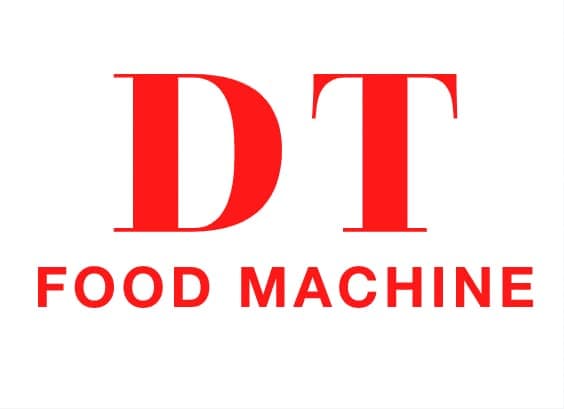1. Introduzione
IL Bubble Washing Machine verdura e frutta è un'attrezzatura avanzata progettata per la pulizia di prodotti freschi utilizzando una combinazione di Immersione in acqua E Agitazione delle bolle d'aria. Questo metodo di pulizia è gentile, efficiente, e rispettoso dell'ambiente, rendendolo adatto sia per prodotti delicati che per quelli fermi.
Come richiedono sempre più consumatori globali pronto da mangiare, pre-lavaggio, e prodotti certificati organici, I processori si stanno aggiornando dal tradizionale lavaggio manuale a completamente automatizzato Sistemi di lavaggio delle bolle.
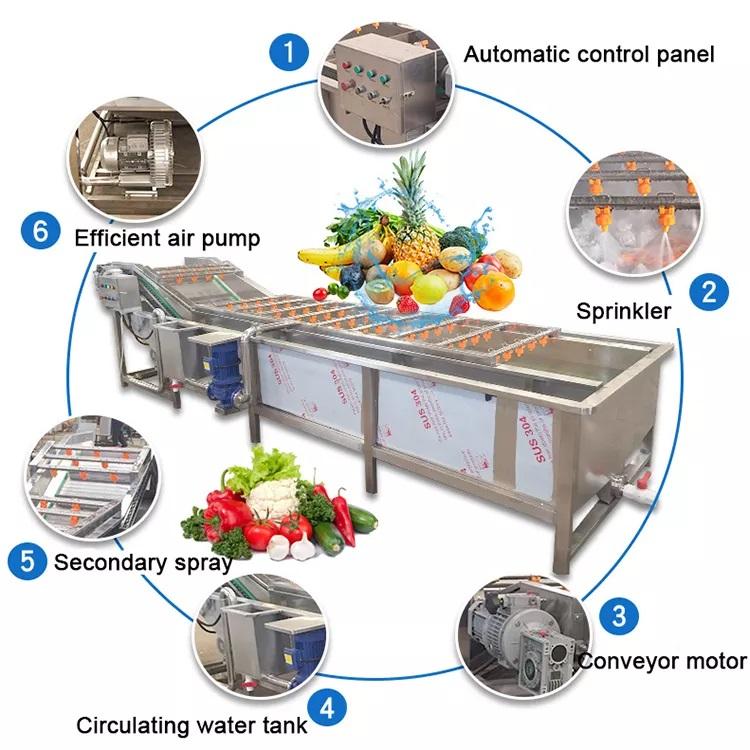
1.1 Perché il lavaggio delle bolle è importante nella moderna trasformazione degli alimenti
- Conformità alla sicurezza alimentare
Agenzie di regolamentazione come la FDA, Commissione UE, e la CFIA richiede ai produttori di alimenti per ridurre al minimo la contaminazione microbica, residui di pesticidi, e detriti fisici. - Conservazione della qualità del prodotto
Il lavaggio delle bolle impedisce i lividi, scolorimento, e perdita di nutrienti, particolarmente importante per i mercati delle esportazioni. - Efficienza operativa
Gestisce volumi alti - da 500 kg/h per piccole piante A 10,000+ kg/h per grandi strutture industriali.
2. Come funziona una lavatrice a bolle
UN Bubble Washing Machine Vegetable and Fruit Utilizza bolle d'aria generate da un soffiatore per agitare delicatamente i prodotti in acqua, allentando sporco e contaminanti.
2.1 Il flusso di processo
- Caricamento
Produrre entra in un trasportatore o travicella manuale. - Immersione del serbatoio dell'acqua
Frutta e verdura sono completamente sommersi. - Iniezione di bolle
L'aria compressa entra attraverso i tubi perforati, Creare turbolenza. - Separazione sporca
Le particelle pesanti si depositano, I detriti leggeri galleggiano via. - Risciacquo finale
Pulisci spray d'acqua Rimuovere eventuali contaminanti residui. - Scarico
Un trasferimento di trasporto produce alla fase di elaborazione successiva.
2.2 Scienza chiave dietro la pulizia delle bolle
- Effetto idrodinamico: Le bolle creano micro-correnti che penetrano con le pieghe fogliari.
- Riduzione della tensione superficiale: Le bolle d'aria riducono l'adesione tra sporco e producono pelle.
- Arricchimento di ossigeno: Aiuta a mantenere la freschezza durante la pulizia.
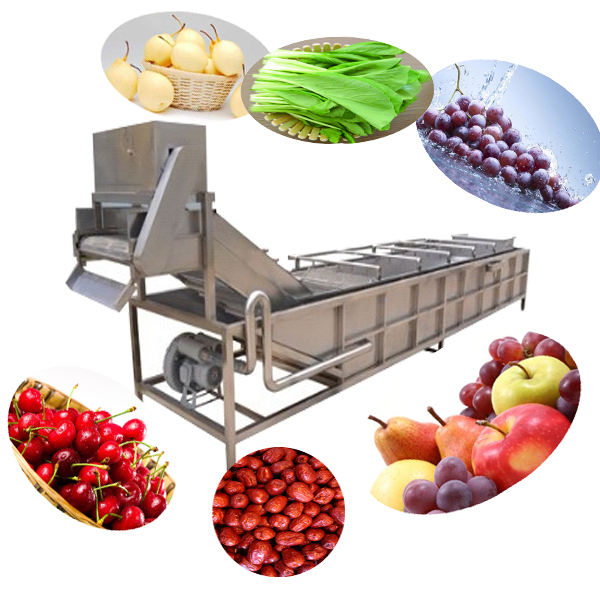
3. Design della macchina & Componenti
IL Bubble Washing Machine Vegetable and Fruit è progettato per durata, igiene, e facile pulizia.
| Componente | Funzione |
|---|---|
| Serbatoio dell'acqua | Contiene la soluzione di lavaggio. |
| Biancellino d'aria | Genera aria per la produzione di bolle. |
| Trasportatore mesh | Mosse producono attraverso la zona di pulizia. |
| Trappola per sedimenti | Raccoglie detriti pesanti. |
| Overflow outlet | Rimuove le impurità galleggianti. |
| Sezione di risciacquo | Fornisce spray per acqua pulita finale. |
| Pannello di controllo | Gestisce la velocità, flusso d'aria, e circolazione dell'acqua. |
Materiale: Acciaio inossidabile SUS304 (standard), SUS316 per prodotti altamente acidi.
4. Tabella dei parametri tecnici
| Modello | Capacità (kg/h) | Energia (kW) | Volume dell'acqua (l) | Dimensioni (mm) | Peso (kg) | Materiale |
|---|---|---|---|---|---|---|
| DT-500 | 500 | 2.2 | 400 | 3000× 1000 × 1300 | 280 | Sus304 |
| DT-1000 | 1000 | 3.7 | 600 | 4000× 1200 × 1300 | 380 | Sus304 |
| DT-2000 | 2000 | 5.5 | 900 | 5000× 1400 × 1350 | 520 | Sus304 |
| DT-3000 | 3000 | 7.5 | 1200 | 6000× 1500 × 1400 | 650 | Sus304 |
| DT-5000 | 5000 | 11 | 1500 | 8000× 1600 × 1450 | 950 | Sus304 |
5. Applicazioni del prodotto
- Verdure a foglia: Lattuga, spinaci, cavolo, cavolo.
- Ortaggi a radice: Carote, patate, ravanelli, barbabietole.
- Frutta: Fragole, uva, mele, agrumi.
- Erbe: Menta, basilico, coriandolo.
- Piante medicinali: Ginseng, crisantemo.
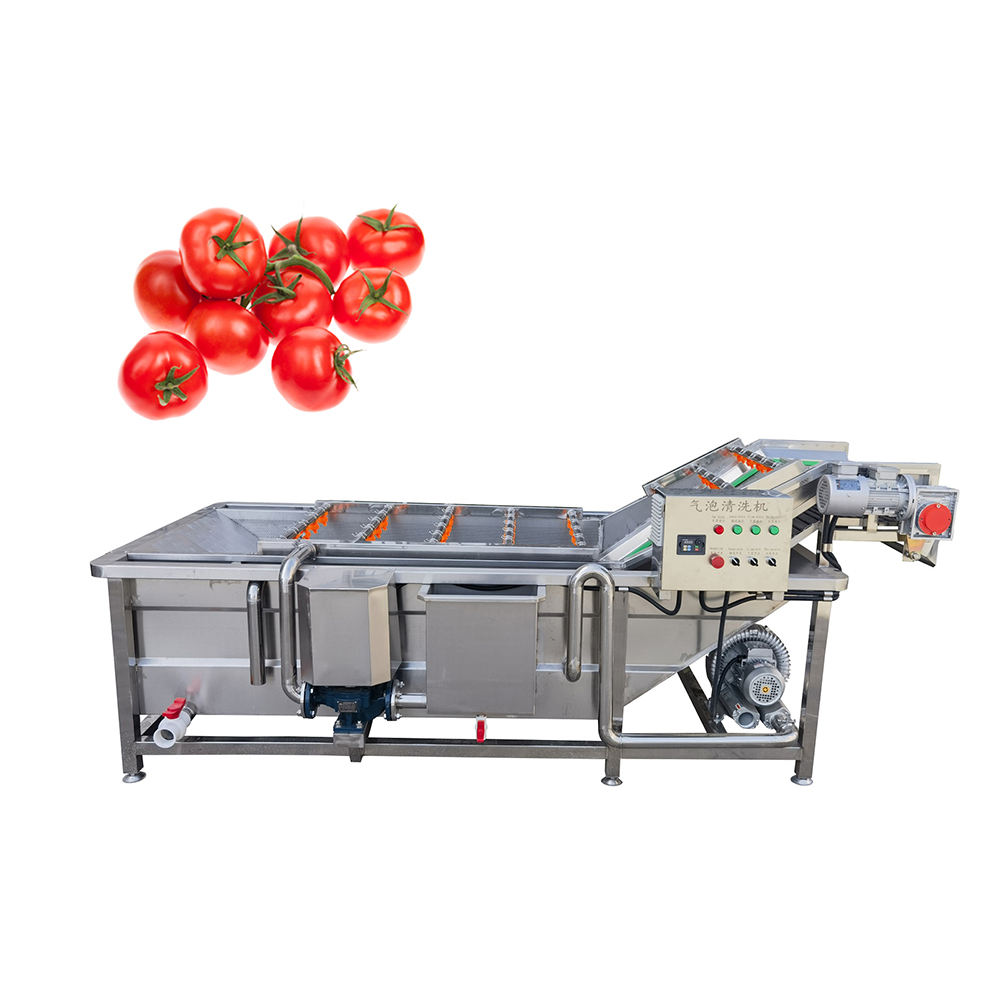
6. Vantaggi rispetto ad altri metodi di lavaggio
| Caratteristica | Bubble Washing Machine | Lavaggio a spruzzo | Lavaggio manuale |
|---|---|---|---|
| Danno da produrre | Molto basso | Medio | Variabile |
| Pulizia di completezza | Alto | Medio | Basso |
| Requisito del lavoro | Basso | Medio | Alto |
| Efficienza dell'uso dell'acqua | Alto | Medio | Basso |
7. Guida all'installazione
- Seleziona posizione - Piano di livello, vicino ad acqua & drenaggio.
- Installa utilità -Connetti la potenza 3-fase, Inletti d'acqua, e drenaggio.
- Assemblaggio - Attacca il soffiatore, trasportatore, e risciacquare le sezioni.
- Test - Corri con acqua solo per verificare la presenza di perdite.
8. Suggerimenti per l'operazione
- Pre-risellare i prodotti pesantemente sporchi prima del caricamento.
- Regolare l'intensità della bolla per oggetti delicati.
- Mantenere bassa la temperatura dell'acqua per mantenere la freschezza.
9. Programma di manutenzione
| Frequenza | Azione |
|---|---|
| Quotidiano | Drenare & serbatoio pulito, Filtri risciacquo. |
| Settimanale | Ispeziona il soffiatore e la pompa. |
| Mensile | Rimuovere il ridimensionamento, Sanistica sanitaria. |
| Annuale | Sostituire i sigilli, cuscinetti. |
10. Acqua & Caratteristiche di risparmio energetico
- Sistema di ricircolo riutilizza fino a 80% di acqua.
- Rimozione dei detriti automatici estende la vita idrica.
- Velocità del soffiatore variabile riduce l'uso di energia.
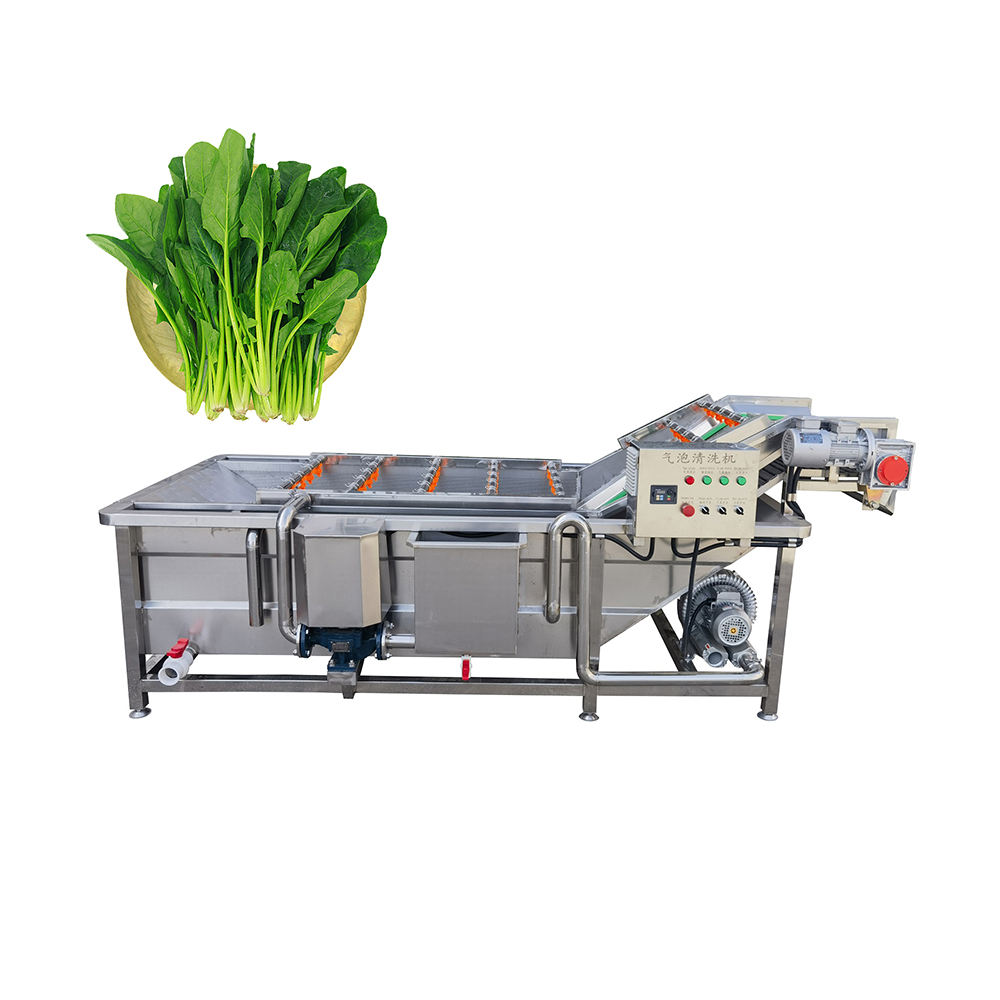
11. Casi studio
Caso 1 - Processore verde a foglia in California
- Capacità: 3000 kg/h
- Risultato: Lavoro ridotto di 70%, Uso dell'acqua di 40%.
- ROI: Raggiunto in 14 mesi.
Caso 2 - esportatore di bacche in Cile
- Capacità: 2000 kg/h
- Risultato: Ridotto danno lividi da 6% a sotto 1%.
12. Tendenze del mercato
- Crescente domanda di Produttori lavati con certificati organici.
- Aumento dell'adozione in Asia-Pacifico A causa dei mercati di esportazione.
- Integrazione con macchine di smistamento ottico.
13. Come scegliere la macchina giusta
- Requisiti di capacità
- Tipo di prodotto
- Disponibilità dello spazio
- Obiettivi di budget e ROI
- Supporto post-vendita
14. Gamme di prezzo
- Piccolo (500–1000 kg/h): $2,500- $ 5.000
- Medio (2000–3000 kg/h): $6,000- $ 10.000
- Grande (5000+ kg/h): $12,000- $ 20.000+
15. FAQ estese
Q: Può essere usato per i frutti di mare?
UN: SÌ, con adeguata protezione della corrosione.
Q: Può connettersi alle macchine per peeling?
UN: SÌ, comunemente integrato in linee di elaborazione complete.
Q: È disponibile la disinfezione dell'ozono?
UN: SÌ, Come componente aggiuntivo opzionale.
16. Guida per la risoluzione dei problemi
| Problema | Possibile causa | Soluzione |
|---|---|---|
| Bolle deboli | Pressione a bassa ventione | Controlla il filtro del soffiatore |
| Scarsa pulizia | Serbatoio sovraccarico | Ridurre la velocità di avanzamento |
| Overflow d'acqua | Scarico bloccato | Outlet pulito |
17. Conclusione
UN Bubble Washing Machine Vegetable and Fruit non è solo un dispositivo di pulizia: è un produttività, qualità, e investimenti di sicurezza. Con il modello giusto, Puoi aumentare la throughput, Migliorare l'igiene, e ridurre i costi operativi.
